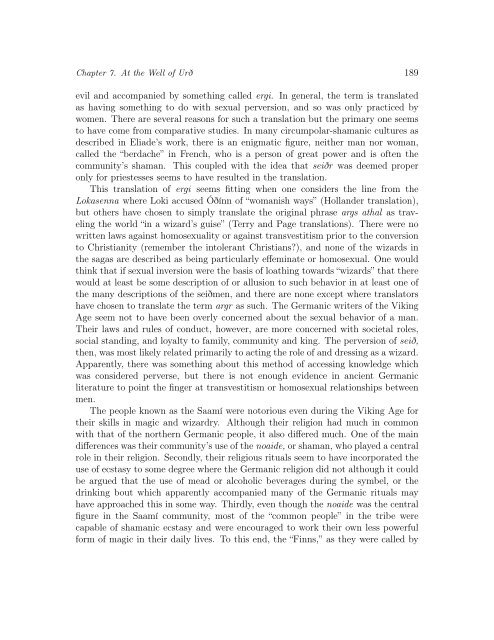Untitled - Awaken Video
Untitled - Awaken Video
Untitled - Awaken Video
You also want an ePaper? Increase the reach of your titles
YUMPU automatically turns print PDFs into web optimized ePapers that Google loves.
Chapter 7. At the Well of Urð 189<br />
evil and accompanied by something called ergi. In general, the term is translated<br />
as having something to do with sexual perversion, and so was only practiced by<br />
women. There are several reasons for such a translation but the primary one seems<br />
to have come from comparative studies. In many circumpolar-shamanic cultures as<br />
described in Eliade’s work, there is an enigmatic figure, neither man nor woman,<br />
called the “berdache” in French, who is a person of great power and is often the<br />
community’s shaman. This coupled with the idea that seiðr was deemed proper<br />
only for priestesses seems to have resulted in the translation.<br />
This translation of ergi seems fitting when one considers the line from the<br />
Lokasenna where Loki accused Óðínn of “womanish ways” (Hollander translation),<br />
but others have chosen to simply translate the original phrase args athal as traveling<br />
the world “in a wizard’s guise” (Terry and Page translations). There were no<br />
written laws against homosexuality or against transvestitism prior to the conversion<br />
to Christianity (remember the intolerant Christians?), and none of the wizards in<br />
the sagas are described as being particularly effeminate or homosexual. One would<br />
think that if sexual inversion were the basis of loathing towards “wizards” that there<br />
would at least be some description of or allusion to such behavior in at least one of<br />
the many descriptions of the seiðmen, and there are none except where translators<br />
have chosen to translate the term argr as such. The Germanic writers of the Viking<br />
Age seem not to have been overly concerned about the sexual behavior of a man.<br />
Their laws and rules of conduct, however, are more concerned with societal roles,<br />
social standing, and loyalty to family, community and king. The perversion of seið,<br />
then, was most likely related primarily to acting the role of and dressing as a wizard.<br />
Apparently, there was something about this method of accessing knowledge which<br />
was considered perverse, but there is not enough evidence in ancient Germanic<br />
literature to point the finger at transvestitism or homosexual relationships between<br />
men.<br />
The people known as the Saamí were notorious even during the Viking Age for<br />
their skills in magic and wizardry. Although their religion had much in common<br />
with that of the northern Germanic people, it also differed much. One of the main<br />
differences was their community’s use of the noaide, or shaman, who played a central<br />
role in their religion. Secondly, their religious rituals seem to have incorporated the<br />
use of ecstasy to some degree where the Germanic religion did not although it could<br />
be argued that the use of mead or alcoholic beverages during the symbel, or the<br />
drinking bout which apparently accompanied many of the Germanic rituals may<br />
have approached this in some way. Thirdly, even though the noaide was the central<br />
figure in the Saamí community, most of the “common people” in the tribe were<br />
capable of shamanic ecstasy and were encouraged to work their own less powerful<br />
form of magic in their daily lives. To this end, the “Finns,” as they were called by
















